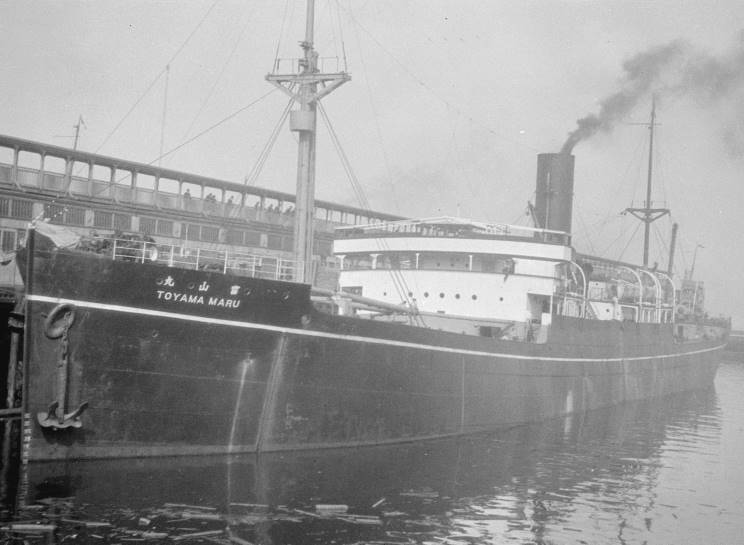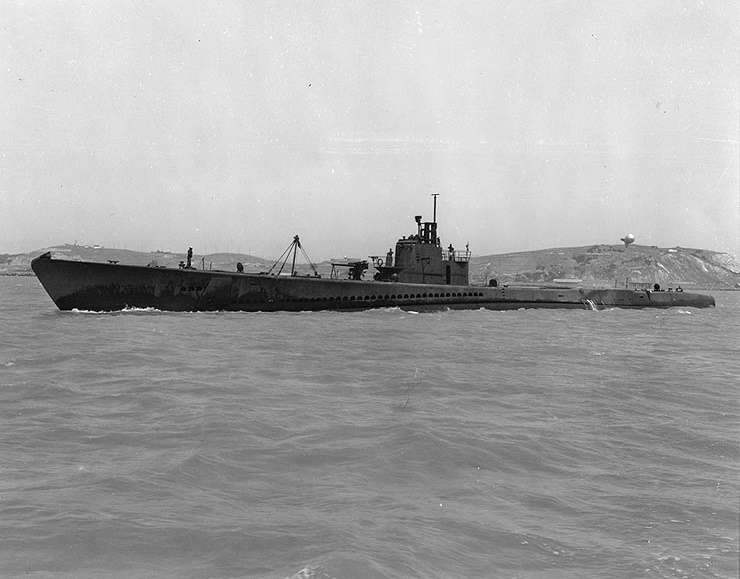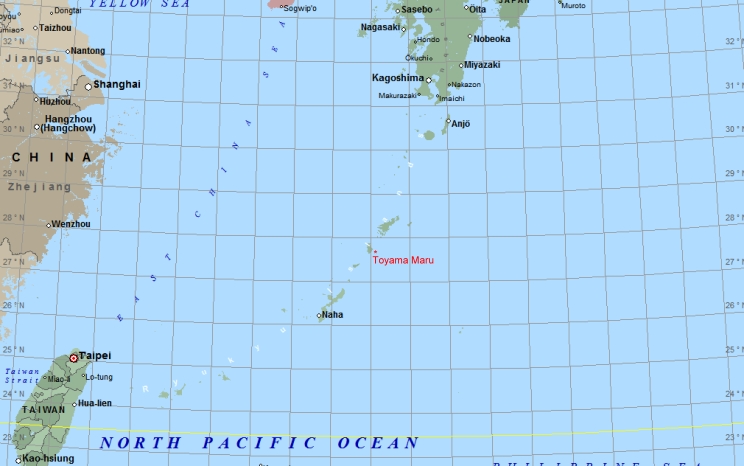|
The freighter Toyama Maru was launched at Mitsubishi in Nagasaki, Japan on Mar. 20, 1915 and completed the next month. She was 445' long with a beam of 58' and she drew 34' of water. A single funnel, twin screw ship of 7,085 gross tons she was owned by Nippon Yusen K.K. in Tokyo. She was fitted with four steam turbines geared to the two shafts giving her a speed of about 13 knots. In the Great War she carried cargo to Europe and later was placed in service to the U.S.A. and Canada, later she served Calcutta and India. She seems to have had an uneventful career until Sept. of 1941 when she was requisitioned by the Imperial Japanese Army. She was converted into a transport and was involved in the Philippine landings and the resupply of Singapore and Palau among other places. The ship gained infamy as a Hell Ship used to transport prisoners of war in the most appalling conditions. After the war one Genichiro Nimori was prosecuted for war crimes and cases of abuse that occurred aboard the Toyama Maru were used in evidence. Specifically the mistreatment of Canadian prisoners on a voyage in Dec. 1943 from Hong Kong to Japan. He was later sentenced to fifteen years in prison. On June 10, 1944 USS Sturgeon SS-187 left Midway for her 11th war patrol, she was under the command of Lt. Commander Charlton L. Murphy, USN who had commanded the boat since Aug. of 1943. Eight days later Toyama Maru left Moji, Japan in a convoy bound for Okinawa. She was carrying 4,000 troops of the Japanese 44th Independent Mixed Brigade (some sources indicate she had 6,000). It is difficult to imagine how the Army managed to cram 4,000 men into this ship (6,000 would be harder to envision). Just given normal bodily functions let alone food and water, the voyage must have been incredibly uncomfortable. The mass of human cargo was not the only thing the ship was carrying. She also had a large amount of gasoline in tin cans, which was stored under the men. At 0100 on June 29, 1944 the soundman on USS Sturgeon reported hearing screws, but his experience led him to believe the sounds were from a submarine. The boat was running on the surface and nothing could be seen from the conning tower so the contact was avoided and the boat continued toward Tokunoshima Island, which seems to have been the destination. At 0433 the boat submerged only five miles from the island. Less than one hour later smoke was sighted on the horizon. It took fifty minutes more for Lt. Cdr. Murphy to identify a convoy through his periscope. He saw one large freighter, four smaller freighters, one small transport, six small craft and as many as a dozen trawler type escorts. He could also see they had air cover. Murphy reported that the sea was flat calm and visibility was unlimited, while this sounds perfect, actually it made it quite dangerous for the submarine. The periscope could be easily sighted causing a wake by the aircraft if the boat made too much speed. The convoy was running a zigzag course at an estimated 8 knots and Murphy set his sights on the largest ship. He identified her as a 9,257 ton freighter of the Anyo Maru type after looking at his recognition guide. He was close, and if you take into account he was looking through a small periscope at a ship almost two miles away, he can not be faulted. The profile of Anyo Maru is quite similar to that of the Lima Maru class (which Toyama Maru was). At 0725 Murphy fired four torpedoes at the unsuspecting ship from over 3,000 yards. From what Murphy could see the ships did not change course, but one minute after he fired the fish, one of the aircraft was seen to dive toward Sturgeon. Murphy went down to 200 feet and waited for the counterattack. However before the first depth charge was dropped, he heard four explosions at the exact time he expected the torpedoes to be on target. They could hear the ship breaking up, but could not see what happened. According to the Japanese three torpedoes hit the ship, one forward, one at #2 hold and one in the engine room. The gasoline she was carrying exploded and turned the ship into an inferno. She broke in half and sank in about one minute leaving men in the burning water where the ship went down. The men in Sturgeon did not have to wait long to feel the wrath of the Japanese escorts, at 0728 the depth charges began to explode around the boat. Seventy depth charges were dropped in an hour causing some damage to the boat. Lights were blown out, valves opened and the bow planes were damaged so much they had to stop using them. The gyro compass was also damaged. The escorts remained hunting the submarine for some time, but were not able to locate the boat. At 1124 Sturgeon came to periscope depth to have a look around, they saw no ships, but did sight two Betty bombers at about 100' heading toward them. An emergency dive again, but this time no bombs were dropped. They remained submerged for the rest of the day, they could hear explosions in the distance, but none were even close to the boat. At 2039 Murphy brought the boat to the surface and headed east at speed. The former Hell Ship now was an earthly hell for the Japanese troops and the crew. The number of men who were killed is unclear. Most sources give the number as 5,400, but the Japanese maritime historian Noma Hisashi gives the number as 3,674 (3,627 troops and 47 crewmen). I tend to agree with the latter number as I think the figure of 6,000 troops is very inflated (Hisashi puts the number of troops onboard at 4,000). I have been unable to locate the original source for the 5,400 number from any official documents. I have very limited resources for Japanese documents and I was not able to find any casualty figures from any official U.S. documents. All sources that have been published (secondary sources) online and in print refer to the 5,400 figure, the true number will probably never be known as the Japanese destroyed many millions of documents just before the war ended. |
© 2005 Michael W. Pocock MaritimeQuest.com (This article was rewritten in 2015) |
 |
Toyama Maru seen in Vancouver, B.C., Canada. |
(Photo by Walter E. Frost) Courtesy of City of Vancouver Archives |
 |
| USS Sturgeon SS-187. |
 |
Location of the loss of Toyama Maru (27.41N - 129.09E). |
© 2015 MaritimeQuest all rights reserved |